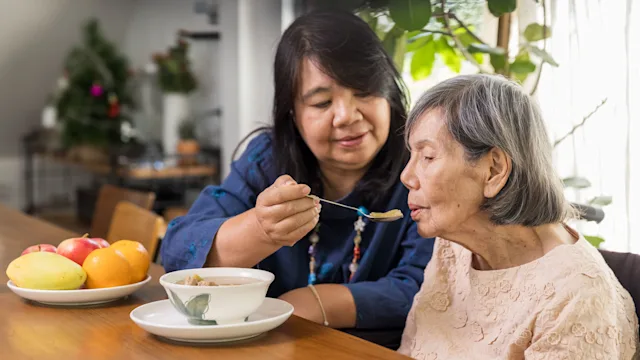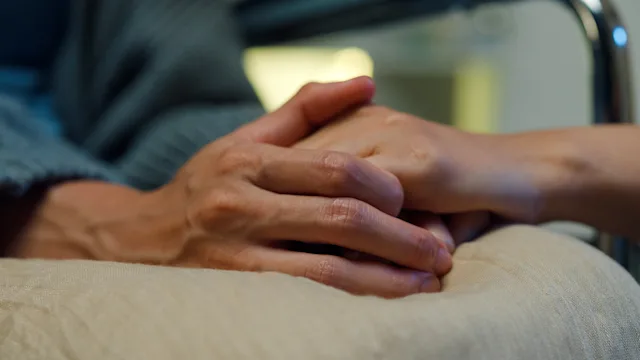Key takeaways:
The process of dying looks different for everyone. But there are common stages that many people go through as they get closer to death.
Signs that death is near include a slower heart rate, colder body temperature, and changes in breathing pattern.
Understanding what happens to the body in the final days can help ease some of the common fears that people have around death.
It can be scary to think about the process of dying and death. For many people, that fear can get in the way of knowing what to expect when someone is nearing the end of their life. But, for individuals and caretakers alike, understanding the process can help ease some of the fear and uncertainty around death.
This article will walk you through the stages of dying and the signs of death. This way, you know what to do if you’re in the presence of someone dying and what to do after a loved one has died.
What are the stages of dying?
The end-of-life journey is different for everyone. Some people are more lucid than others. Some people die more quickly than others. But there are still some typical changes that most people experience in the process of dying.
Initial stage
This stage occurs 1 to 3 months before dying. Changes in the initial stage include:
Less hunger and thirst
More sleeping more than usual
Unintentional weight loss
Later stage
This stage occurs 1 to 2 weeks before dying. Changes in the later stage include:
Social withdrawal
Cooler body temperature
Heart rate slows down or speeds up
Noisy breathing or cough
Confusion, possibly hallucinations
Restlessness (picking at clothes or bed sheets)
Increased pain
Last stage
This stage occurs days or hours before dying. Changes in the last stage include:
Short bursts of energy
Moments of clarity (for someone who typically is confused)
Breathing rate slows down or speeds up
Noticeable pauses in breathing
Skin color changes (pale or bluish lips, fingers, or toes)
While the way someone moves through the weeks and days before death can vary a lot, the final hours of life tend to be more alike.
Read more like this
Explore these related articles, suggested for readers like you.
When someone is close to death, their heart rate and blood pressure will begin to drop. Both of these changes affect the circulation to the organs. You may notice they become:
Less alert and more more sleepy
Cooler to the touch, especially in their hands and feet
Slow and shallow in their breathing
What are the signs that someone has died?
When someone dies, typically the first thing you will notice is that their breathing stops. Within moments, the heart will stop beating, too.
Here are the signs that someone has died:
They are no longer breathing.
Their eyes are not moving, and their pupils no longer change size. Their eyelids may be fully or only partially shut.
Their muscles are completely limp. In the hours after death, their muscles will start to stiffen.
Their skin appears pale or waxy.
They may have a final release of their bowel or bladder.
Even with all these signs, accepting that a person has died can be hard. And it can be easy to feel helpless, overwhelmed, or lost. But there are things you can do to prepare for the last few moments that may help the process feel less upsetting.
What should you do if you are in the presence of someone who is dying?
If you are caring for someone who is dying, it can be hard to know what to do, what to say, or how to act. It’s OK to give yourself grace in these moments.
Some people may be able to tell you what they want or need in the hours leading up to death. But many times, someone who is dying may no longer be able to communicate with you.
Even if they seem to be unaware of their surroundings, sitting with them can provide comfort. If you feel up to it, hold their hand. Or try talking or reading to them. Most people agree that a dying person can still hear sounds and feel physical touch, even if they can’t respond.
To help provide relief, you can:
Apply lip balm to dry lips.
Offer ice chips if their mouth is dry.
Apply lotion to areas of dry skin.
Gently turn them from one side, to their back, to their other side. This will help avoid pressure sores.
Open the windows if they feel warm.
Provide a blanket if they feel cold.
Create a soothing environment by softening the lighting or playing music they enjoy.
It also helps to know that breathing can become especially noisy as a person is closer to death. They might have a harder time clearing their saliva from their mouth and the back of their throat. Although hard to watch, this type of breathing does not mean they are suffering.
Still, it can be very stressful if the person you care for expresses pain or becomes agitated. If you don’t have medications on hand already, don’t hesitate to reach out to their healthcare provider. There are several medications that can help to ease some of these symptoms.
Do you need to call for emergency help?
If a person wishes to die at home and their death is expected, you do not need to call emergency services. A care plan can help you know a person’s wishes for their death and specify where they wish to die.
A care plan will also say if they have a DNR or “do-not-resuscitate” order. This means that they do not want CPR done if their heart stops beating. Any person can request a DNR at any time to be signed by a provider. Often, people with terminal illness or chronic disease will have a signed DNR order.
Not calling for emergency help does not mean that you are letting someone die. In these moments, try to remember that you are honoring their wishes in their final moments of life.
What do you do after someone has died
Many people spend time emotionally preparing for the moments leading up to a loved one’s death. But it can be hard to think about what happens afterward. Below is some guidance to help you through the hours, days, and weeks after their death.
First hours after death
It is OK to spend time with your loved one after they have died. This is a very personal decision. And there is no right or wrong way to act in these moments. Some people want more time to sit with someone after they have died, while others find more comfort in taking the next steps.
Once you and your loved ones are ready, the next step is to make arrangements to transport the body. This process partly depends on where the death took place:
At home without hospice: Contact your local funeral home, medical examiner’s office, local health department, or the person’s primary provider. They will help you coordinate the next steps.
At home with hospice: A hospice nurse will help with next steps.
In a healthcare facility: Hospitals and long-term care facilities have experienced staff who will guide you through next steps.
It helps to know that there are local laws in place for this step, too. Most states require that the body is preserved within 24 to 48 hours of death.
After someone dies, you will also need to get a declaration of death (pronouncement of death) as soon as possible. It is a form that states the time, location, and likely cause of death. This can be done by a provider, hospice nurse, or nursing facility. It is needed to officially create the death certificate.
This is also the time when most people like to call family, friends, and other loved ones to let them know about the death.
Days to weeks after death
The days that follow are usually filled with planning funeral services. But there are a few other items to keep in mind in the weeks after someone’s death. It’s a good idea to:
Secure any personal property, like their house, car, or valuable belongings.
Arrange pet or child care, if needed.
Forward mail.
Notify their employer, if applicable.
Contact the Social Security Administration, if they are receiving checks, to stop them.
Notify banks and credit agencies to close accounts and prevent identity theft.
Cancel their driver’s license.
Cancel credit cards.
Terminate insurance policies.
Cancel services that are no longer needed, such as internet subscriptions.
Taking the next steps can feel overwhelming — impossible, even. Remember that you are not alone. And leaning on others for support can help.
Months after death
The first days and weeks after someone’s death can be so busy that it doesn’t leave a lot of time for processing and grieving. Sometimes it takes a little while for the grieving process to set in.
There are resources that exist to help ease some of the burden and the feelings that you may experience after a loved one dies. You may want to:
Join a local bereavement group.
Talk to a grief counselor or therapist.
Contact a helpline. For example, dialing 211 brings you to a call center that can help find local resources. Volunteers at the AARP Friendly Voice answer the phone to say hello and talk.
Different resources may help at different times. And that’s OK. The process of grieving isn’t a straight line. There will be ups and downs. Your emotional needs may also change as more time passes. It may be worth exploring different kinds of support depending on where you are in the grieving process.
The bottom line
The signs that someone is nearing death are different for every person, which can add to the fear that most people feel around death. But understanding the dying process may help alleviate some of the stress and burden that naturally accompanies the passing of a loved one. There are things you can do to bring comfort and peace for both yourself and someone you care for in the final hours. And the same is true after their death. It’s OK to lean on others for support in the time that follows.

Why trust our experts?


References
Centers for Disease Control and Prevention. (n.d.). Grief.
Driessen, A., et al. (2021). Placing death and dying: Making place at the end of life. Social Science & Medicine.
Healthdirect. (2021). The physical process of dying.
Hospice Foundation of America. (n.d.). Signs of approaching death.
National Institute on Aging. (2022). Providing care and comfort at the end of life.
National Institute on Aging. (2022). What to do after someone dies.
NHS Inform. (2023). Body changes at the end of life. National Health Service.
Potts, L. (2022). What to do when a loved one dies. AARP.
Zaman, M., et al. (2021). What would it take to die well? A systematic review of systematic reviews on the conditions for a good death. The Lancet. Healthy Longevity.


















